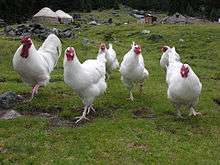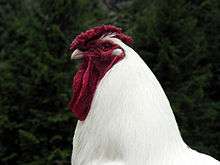Schweizer (chicken)
 | |
| Conservation status | recovering |
|---|---|
| Other names |
|
| Country of origin | Switzerland |
| Traits | |
| Weight | Male: 2.8–3.5 kg[1] |
| Female: 2.4–2.8 kg[1] | |
| Comb type | rose |
| Classification | |
|
Chicken Gallus gallus domesticus | |
The Schweizer, German: Schweizerhuhn or "Swiss chicken", is a Swiss breed of domestic chicken. It was bred in 1905 in Amriswil, in the canton of Thurgau, in north-east Switzerland. It is kept mainly in German-speaking areas of the country.[1]
History

The Schweizer breed was created in 1905 by Alfred Weiss, who cross-bred various chicken breeds, mainly white Orpingtons and Wyandottes, to produce a good dual-purpose chicken. A breed association was formed in 1910, and a breed standard was established. The breed had a period of success between the First and Second World Wars, but after the war the industrialisation of agriculture and the advent of imported hybrid layer breeds led to rapid decline in its popularity. By 1971 the breeders' club had only six members. Since 1991 the conservation of the breed has been led by ProSpecieRara;[1] a herd-book was established in 1993. In 2010 a population of 1600–1650 was reported to DAD-IS.[2] Breed numbers are slowly rising.[1]
Characteristics
The Schweizer breed is entirely white, with a red rose comb. Cocks weigh 2.8–3.5 kg and hens 2.4–2.8 kg.[1] Hens lay about 120 eggs per year.[2] The Schweizerhuhn is listed in the Swiss Slow Food Ark of Taste.[3]
References
- 1 2 3 4 5 6 Schweizerhuhn (in German). ProSpecieRara Schweiz. Accessed August 2014.
- 1 2 Breed data sheet: Schweizer Huhn/Switzerland. Domestic Animal Diversity Information System of the Food and Agriculture Organization of the United Nations. Accessed August 2014.
- ↑ Arche des Geschmacks: Stand 2013 (in German). Slow Food CH. Accessed August 2014.